-
Nyjer Feeders are Busy Now
 They’re the last ones of the season to nest and raise their young, they’re also the only ones who molt twice per year. It really puts goldfinches in a class of their own. It’s the busy season for them, feeding the tiny black seed almost exclusively to babies. During the year, spells of non-activity may be common around nyjer feeders… but not now!
They’re the last ones of the season to nest and raise their young, they’re also the only ones who molt twice per year. It really puts goldfinches in a class of their own. It’s the busy season for them, feeding the tiny black seed almost exclusively to babies. During the year, spells of non-activity may be common around nyjer feeders… but not now!If you offer nyjer or thistle seed year-round, chances are great these birds will stick around. They won’t nest in a birdhouse, but prefer mature trees and shrubs for building their digs. Considered resident birds, in winter you’ll see dull brown-olive plumage, but their sweet song will still grace the garden on the dreariest days. A fresh water source will further entice these friendly fliers.
A fickle seed nyjer can be, it must be fresh for the birds to partake. Should the seed sit in your feeder too long, it may become moldy or rancid and they won’t touch it. One of the benefits of this long tube feeder is the ability to fill it from both ends. By alternating top and bottom refills, there’s no way for older seed to accumulate at the bottom like most feeders.
Another popular style is mesh or screen, offering an all-over feeding space as opposed to individual perches. In recycled plastic, some are durable enough to last a lifetime.

And the last benefit of thistle? It won’t germinate! You’ll never see a nasty weed below these feeders. So fill it up, keep seed fresh, offer a bathing spot and American goldfinches are bound to claim your garden as home sweet home!
-
Good Luck with Parts for Bird Brain Hummingbird Feeders
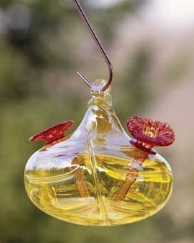 They were really great feeders, so it’s sad the company’s no longer around. Trying to find replacement parts for the old Bird Brain hummingbird feeders could pose quite the challenge. A recent customer would absolutely attest to this fact.
They were really great feeders, so it’s sad the company’s no longer around. Trying to find replacement parts for the old Bird Brain hummingbird feeders could pose quite the challenge. A recent customer would absolutely attest to this fact.Even their feeders with the rubber or plastic flowers… nada, zip, zilch, replacements just don’t exist.
But wait… the light bulb goes off and it’s a brainstorm for Bird Brain. Parasol! Yes some Parasol’s feeders use a red glass flower with a long stem. But will they fit correctly? The only way to know is try and see. So with said customer on the phone, one glass hummingbird feeder from each company was pulled to experiment.
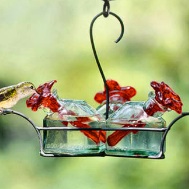
It worked – like a charm too! The glass flowers actually looked better than the original parts. Even with the stem a little bit shorter, it doesn’t have much bearing as hummingbird’s tongues are twice as long as their beaks. Sometimes there’s concern that the feeder port doesn’t reach to the bottom of its vessel, but truth is, it’s not required.
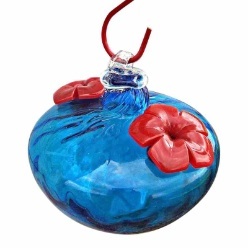 Even their styles with rubber feeder ports (which had no stems at all) will accommodate Parasol’s feeder tubes beautifully. Doh… forgot to photograph the new combination!
Even their styles with rubber feeder ports (which had no stems at all) will accommodate Parasol’s feeder tubes beautifully. Doh… forgot to photograph the new combination!So you’re actually in luck if searching for Bird Brain feeder port replacements, because Parasol’s work great!
By the way, if there’s been a lull at your hummingbird feeders you’re not alone. Many people are saying the same thing. It could be the sprites are nesting, or maybe there’s just not as many this year? In either case… they’re back! We spotted several last week, and our local bird buddies said the same thing. So it’s time to clean your feeder and be sure nectar stays fresh. And in about one more month, prepare to be dazzled when their migration begins.
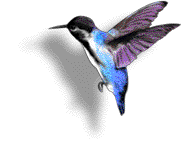 You may even need to another feeder!
You may even need to another feeder! -
Thistle Feeders are in High Gear Once Again!
 It may be officially summer, but the tail end of spring nesting season is still going strong. Goldfinches are just starting to nest now, which means you’ll be seeing a whole lot of yellow at thistle feeders in the next 2-3 months.
It may be officially summer, but the tail end of spring nesting season is still going strong. Goldfinches are just starting to nest now, which means you’ll be seeing a whole lot of yellow at thistle feeders in the next 2-3 months.If you’re not offering thistle yet, you may be missing out! The American Goldfinch is a favored backyard songbird as their summer plumage, friendly disposition and sweet song are simply a pleasure to have around the garden. And unlike other birdseed, thistle seed won’t germinate… which is also a pleasure in the garden 🙂
Goldfinches don’t use birdhouses, so there’s no luring them in with that. They’ll raise their broods in mature hedges or trees, constructing nests of woven plant fibers and down. You can encourage them with some nesting materials placed in the vicinity of thistle feeders. They’re partial to Hummer Helper, the hummingbird nesting material, feathers and other fibrous nest offerings.
Unlike some more aggressive birds, goldfinches are quite demure, they’d rather fly off than fight for a spot at the feeder. This where lots of perches, or an all-over feeding space to accommodate them are ideal. Thistle socks are another great choice for goldfinches’ busy time of year. You can easily offer several different feeding spots, without spending a whole lot! Parents will feed babies thistle seed almost exclusively at first, sometimes mixed with finely chopped sunflower bits, you’ll see finches consuming this seed mix too.
As always, fresh water is critical to any bird’s environment. Keeping your bird bath clean is important stuff, for them and for your yard – especially in warm summer weather. Keep water shallow (no more than two inches) and keep it fresh… and they will come!
Oh wait, once goldfinches molt again in September they’ll turn an olive-drab color… but don’t quit feeding them. If you offer thistle year-round, their electric yellow plumage will grace your yard every summer!
